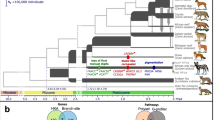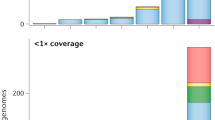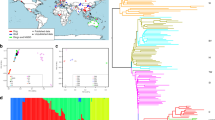Abstract
The domestication of dogs was an important episode in the development of human civilization. The precise timing and location of this event is debated1,2,3,4,5 and little is known about the genetic changes that accompanied the transformation of ancient wolves into domestic dogs. Here we conduct whole-genome resequencing of dogs and wolves to identify 3.8 million genetic variants used to identify 36 genomic regions that probably represent targets for selection during dog domestication. Nineteen of these regions contain genes important in brain function, eight of which belong to nervous system development pathways and potentially underlie behavioural changes central to dog domestication6. Ten genes with key roles in starch digestion and fat metabolism also show signals of selection. We identify candidate mutations in key genes and provide functional support for an increased starch digestion in dogs relative to wolves. Our results indicate that novel adaptations allowing the early ancestors of modern dogs to thrive on a diet rich in starch, relative to the carnivorous diet of wolves, constituted a crucial step in the early domestication of dogs.
This is a preview of subscription content, access via your institution
Access options
Subscribe to this journal
Receive 51 print issues and online access
$199.00 per year
only $3.90 per issue
Buy this article
- Purchase on Springer Link
- Instant access to full article PDF
Prices may be subject to local taxes which are calculated during checkout



Similar content being viewed by others
References
Ovodov, N. D. et al. A 33,000-year-old incipient dog from the Altai mountains of Siberia: evidence of the earliest domestication disrupted by the last glacial maximum. PLoS ONE 6, e22821 (2011)
Davis, S. J. M. & Valla, F. R. Evidence for domestication of the dog 12,000 years ago in the Natufian of Israel. Nature 276, 608–610 (1978)
Skoglund, P., Gotherstrom, A. & Jakobsson, M. Estimation of population divergence times from non-overlapping genomic sequences: examples from dogs and wolves. Mol. Biol. Evol. 28, 1505–1517 (2011)
Pang, J. F. et al. mtDNA data indicate a single origin for dogs south of Yangtze River, less than 16,300 years ago, from numerous wolves. Mol. Biol. Evol. 26, 2849–2864 (2009)
vonHoldt, B. M. et al. Genome-wide SNP and haplotype analyses reveal a rich history underlying dog domestication. Nature 464, 898–902 (2010)
Coppinger, R. & Coppinger, L. Dogs: a Startling New Understanding of Canine Origin, Behaviour and Evolution (Scribner, 2001)
Hare, B., Wobber, V. & Wrangham, R. The self-domestication hypothesis: evolution of bonobo psychology is due to selection against aggression. Anim. Behav. 83, 573–585 (2012)
Belyaev, D. K. Destabilizing selection as a factor in domestication. J. Hered. 70, 301–308 (1979)
Fang, M., Larson, G., Ribeiro, H. S., Li, N. & Andersson, L. Contrasting mode of evolution at a coat color locus in wild and domestic pigs. PLoS Genet. 5, e1000341 (2009)
Rubin, C. J. et al. Whole-genome resequencing reveals loci under selection during chicken domestication. Nature 464, 587–591 (2010)
Lindblad-Toh, K. et al. Genome sequence, comparative analysis and haplotype structure of the domestic dog. Nature 438, 803–819 (2005)
Koike, N. et al. Brorin, a novel secreted bone morphogenetic protein antagonist, promotes neurogenesis in mouse neural precursor cells. J. Biol. Chem. 282, 15843–15850 (2007)
Cheng, L. et al. Tlx3 and Tlx1 are post-mitotic selector genes determining glutamatergic over GABAergic cell fates. Nature Neurosci. 7, 510–517 (2004)
Napoli, I. et al. The fragile X syndrome protein represses activity-dependent translation through CYFIP1, a new 4E-BP. Cell 134, 1042–1054 (2008)
Weston, M. C., Nehring, R. B., Wojcik, S. M. & Rosenmund, C. Interplay between VGLUT isoforms and endophilin A1 regulates neurotransmitter release and short-term plasticity. Neuron 69, 1147–1159 (2011)
Varga, Z. M. et al. Zebrafish smoothened functions in ventral neural tube specification and axon tract formation. Development 128, 3497–3509 (2001)
Tokuhiro, K., Ikawa, M., Benham, A. M. & Okabe, M. Protein disulfide isomerase homolog PDILT is required for quality control of sperm membrane protein ADAM3 and male fertility. Proc. Natl Acad. Sci. USA 109, 3850–3855 (2012)
Gardner, A. J. & Evans, J. P. Mammalian membrane block to polyspermy: new insights into how mammalian eggs prevent fertilisation by multiple sperm. Reprod. Fertil. Dev. 18, 53–61 (2006)
Boomgaarden, I., Vock, C., Klapper, M. & Doring, F. Comparative analyses of disease risk genes belonging to the acyl-CoA synthetase medium-chain (ACSM) family in human liver and cell lines. Biochem. Genet. 47, 739–748 (2009)
Nichols, B. L. et al. The maltase-glucoamylase gene: common ancestry to sucrase-isomaltase with complementary starch digestion activities. Proc. Natl Acad. Sci. USA 100, 1432–1437 (2003)
Wright, E. M., Loo, D. D. F. & Hirayama, B. A. Biology of human sodium glucose transporters. Physiol. Rev. 91, 733–794 (2011)
Meisler, M. H. & Ting, C. N. The remarkable evolutionary history of the human amylase genes. Crit. Rev. Oral Biol. Med. 4, 503–509 (1993)
Simpson, J. W., Doxey, D. L. & Brown, R. Serum isoamylase values in normal dogs and dogs with exocrine pancreatic insufficiency. Vet. Res. Commun. 8, 303–308 (1984)
Worth, C. L., Preissner, R. & Blundell, T. L. SDM-a server for predicting effects of mutations on protein stability and malfunction. Nucleic Acids Res. 39, W215–W222 (2011)
Pei, L. et al. NR4A orphan nuclear receptors are transcriptional regulators of hepatic glucose metabolism. Nature Med. 12, 1048–1055 (2006)
Mochizuki, K., Honma, K., Shimada, M. & Goda, T. The regulation of jejunal induction of the maltase-glucoamylase gene by a high-starch/low-fat diet in mice. Mol. Nutr. Food Res. 54, 1445–1451 (2010)
Andersson, L. Studying phenotypic evolution in domestic animals: a walk in the footsteps of Charles Darwin. Cold Spring Harb. Symp. Quant. Biol. 74, 319–325 (2009)
Diez-Sampedro, A. et al. A glucose sensor hiding in a family of transporters. Proc. Natl Acad. Sci. USA 100, 11753–11758 (2003)
Hediger, M. A., Mendlein, J., Lee, H. S. & Wright, E. M. Biosynthesis of the cloned intestinal Na+ glucose cotransporter. Biochim. Biophys. Acta 1064, 360–364 (1991)
Perry, G. H. et al. Diet and the evolution of human amylase gene copy number variation. Nature Genet. 39, 1256–1260 (2007)
Li, H. et al. The sequence alignment/map format and SAMtools. Bioinformatics 25, 2078–2079 (2009)
Weir, B. S. & Cockerham, C. C. Estimating F-statistics for the analysis of population-structure. Evolution 38, 1358–1370 (1984)
Beissbarth, T. & Speed, T. P. GOstat: find statistically overrepresented Gene Ontologies within a group of genes. Bioinformatics 20, 1464–1465 (2004)
Scheet, P. & Stephens, M. A fast and flexible statistical model for large-scale population genotype data: applications to inferring missing genotypes and haplotypic phase. Am. J. Hum. Genet. 78, 629–644 (2006)
Dahlqvist, A. Method for assay of intestinal disaccharidases. Anal. Biochem. 7, 18–25 (1964)
Xie, C. & Tammi, M. T. CNV-seq, a new method to detect copy number variation using high-throughput sequencing. BMC Bioinformatics 10, 80 (2009)
Abyzov, A., Urban, A. E., Snyder, M. & Gerstein, M. CNVnator: An approach to discover, genotype, and characterize typical and atypical CNVs from family and population genome sequencing. Genome Res. 21, 974–984 (2011)
Acknowledgements
We thank Järvzoo, Nordens ark and the Canine Biobank at Uppsala University and the Swedish University of Agricultural Sciences for providing samples, Uppsala Genomics Platform at SciLifeLab Uppsala for generating the resequencing data, the UPPNEX platform for assisting with computational infrastructure for data analysis and the Broad Institute Genomics Platform for validation genotyping. The project was funded by the SSF, the Swedish Research Council, the Swedish Research Council Formas, Uppsala University and a EURYI to K.L.-T. funded by the ESF supporting also E.A.; K.M. was funded by the Higher Education Commission, Pakistan.
Author information
Authors and Affiliations
Contributions
K.L.-T. and Å.H. designed the study. K.L.-T. and E.A. oversaw the study. M.-L.A. coordinated and performed the majority of the sample collecting and O.L. and J.M.A. provided samples of critical importance. E.A. performed the SNP detection and selection analyses; A.R. identified candidate causative mutations and analysed haplotypes in CDRs; K.M. detected CNVs bioinformatically; M.T.W. performed phylogenetic analysis and analysed the Canine HD-array data; A.R. performed the maltase activity assay; M.-L.A. validated CNVs and quantified mRNA expression of candidate genes; M.P. performed validation SNP genotyping; E.A., A.R., M.-L.A. and K.L-T. interpreted the data; E.A. and K.L.-T. wrote the paper with input from the other authors.
Corresponding authors
Ethics declarations
Competing interests
The authors declare no competing financial interests.
Supplementary information
Supplementary Information
This file contains Supplementary Discussions sections 1-9, Supplementary references, Supplementary Figures 1-24 and Supplementary Tables 1-25. (PDF 6581 kb)
Supplementary Data 1
This zipped file lists the position of short indels in the canine genome. (ZIP 3569 kb)
Supplementary Data 2
This zipped file lists the position of CNVs in the canine genome. (ZIP 257 kb)
Rights and permissions
About this article
Cite this article
Axelsson, E., Ratnakumar, A., Arendt, ML. et al. The genomic signature of dog domestication reveals adaptation to a starch-rich diet. Nature 495, 360–364 (2013). https://doi.org/10.1038/nature11837
Received:
Accepted:
Published:
Issue Date:
DOI: https://doi.org/10.1038/nature11837
This article is cited by
-
Longevity of companion dog breeds: those at risk from early death
Scientific Reports (2024)
-
Japanese wolves are most closely related to dogs and share DNA with East Eurasian dogs
Nature Communications (2024)
-
Canine Mucosal Artificial Colon: development of a new colonic in vitro model adapted to dog sizes
Applied Microbiology and Biotechnology (2024)
-
The effect of puppyhood and adolescent diet on the incidence of chronic enteropathy in dogs later in life
Scientific Reports (2023)
-
Integrated transcriptomic and proteomic analyses reveal the mechanism of easy acceptance of artificial pelleted diets during food habit domestication in Largemouth bass (Micropterus salmoides)
Scientific Reports (2023)
Comments
By submitting a comment you agree to abide by our Terms and Community Guidelines. If you find something abusive or that does not comply with our terms or guidelines please flag it as inappropriate.



